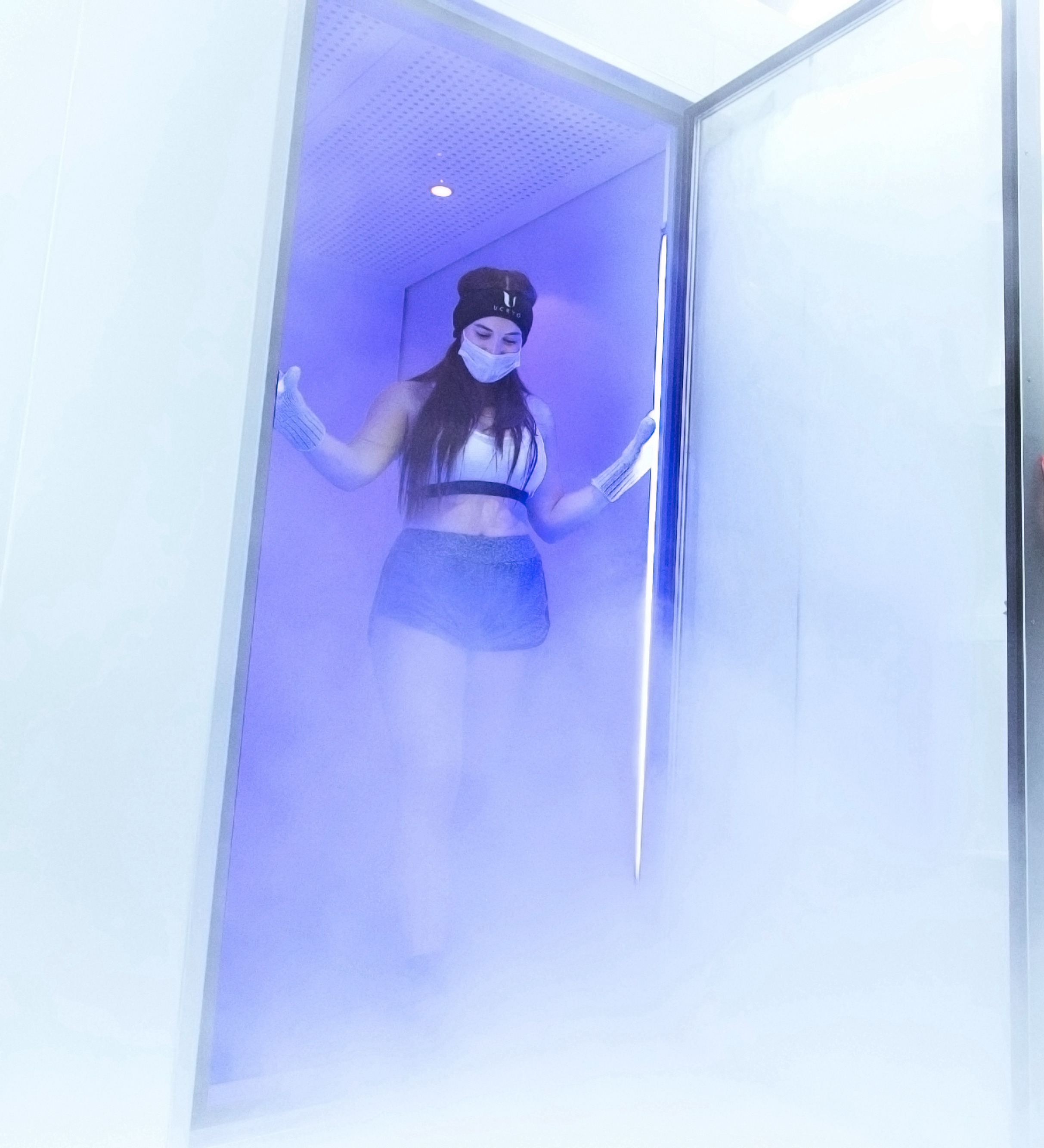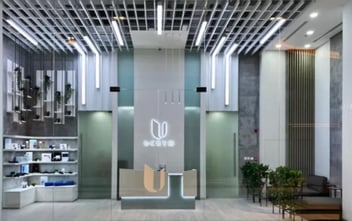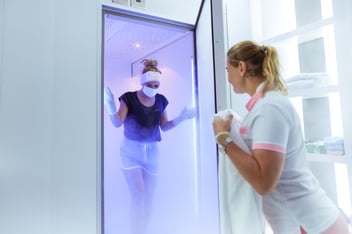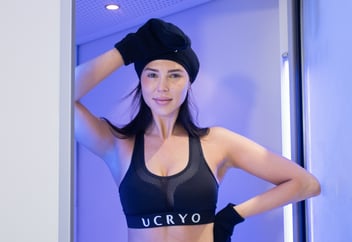Cryotherapy is a type of treatment that uses extreme cold to freeze abnormal cells and tissues. It can treat various skin conditions such as warts, hemangiomas, and skin cancer. Cryotherapy can also work internally to kill tumors.
Cryotherapy has many potential benefits, such as pain relief, muscle healing, improved circulation, reduced inflammation, and enhanced mood. However, cryotherapy also involves some risks, such as frostbite, nerve damage, allergic reactions, and hypothermia. Therefore, it is important to follow safety measures before, during, and after a cryotherapy session.
Why Safety is Crucial in Cryotherapy
Cryotherapy exposes the body to extremely low temperatures, ranging from -95°C to -110°C. This can cause serious harm to the skin, nerves, blood vessels, and organs if not done properly. Some potential risks involved in cryotherapy are:
- Frostbite: This occurs when the skin and underlying tissues freeze due to prolonged exposure to cold. Frostbite can cause blisters, numbness, pain, and permanent tissue damage.
- Nerve damage: This occurs when the nerves are injured by cold or pressure. Nerve damage can cause tingling, burning, weakness, or loss of sensation in the affected area.
- Allergic reactions: This occurs when the immune system reacts to the cold or the substances used in cryotherapy. Allergic reactions can cause itching, swelling, rash, or anaphylaxis (a life-threatening condition that affects breathing and blood pressure).
- Hypothermia: This occurs when the body temperature drops below 35°C. Hypothermia can cause shivering, confusion, drowsiness, slow heartbeat, and loss of consciousness.
Safety measures are not just optional but essential for cryotherapy. They can prevent or minimize the risks and ensure a safe and effective treatment. Safety measures can also enhance the benefits of cryotherapy by optimizing the body’s response to cold.
Pre-Session Safety Measures
Before undergoing cryotherapy, it is important to take some precautions to prepare the body and mind for the treatment. Some of the pre-session safety measures are:
Medical Consultation
It is important to consult a healthcare provider before trying cryotherapy. A medical consultation can help determine if cryotherapy is suitable for your condition and goals. It can also help identify any contraindications or precautions that you need to follow.
Some of the contraindications for cryotherapy are:
- Pregnancy
- Heart disease
- High blood pressure
- Cold allergy
- Open wounds
- Cancer
Eligibility Criteria
Cryotherapy is not for everyone. There are some eligibility criteria that you need to meet before undergoing cryotherapy. Some of the eligibility criteria are:
- You must be at least 18 years old or have parental consent if you are under 18.
- You must be in good physical and mental health.
- You must not have any of the contraindications mentioned above.
- You must not have consumed alcohol or drugs within 24 hours before the session.
Informed Consent
Before starting a cryotherapy session, you need to understand and sign an informed consent form. This form explains the purpose, procedure, benefits, risks, and alternatives of cryotherapy. It also gives you the right to withdraw from the treatment at any time.
Signing an informed consent form means that you agree to participate in cryotherapy voluntarily and with full knowledge of what it entails. It also means that you accept the responsibility for any consequences that may arise from the treatment.
During the Session Safety Measures
During a cryotherapy session, you need to follow some safety measures to protect yourself from the cold and ensure a comfortable experience. Some of the during-session safety measures are:
Proper Attire
What you wear during a cryotherapy session can make a big difference in how you feel and how your body reacts to the cold. You should wear:
- Dry clothing that covers most of your body. For example, a long-sleeved shirt and pants.
- Gloves, socks, and shoes that protect your hands and feet from frostbite.
- A hat or headband that covers your ears.
- A mask or mouthpiece that covers your nose and mouth.
- Underwear that protects your genitals (especially for men).
- A towel or robe that you can wrap around yourself after the session.
You should avoid wearing:
- Wet clothing that can lower your body temperature faster.
- Jewelry or metal objects that can conduct cold and cause burns.
- Lotions or creams that can clog your pores and prevent your skin from breathing.
- Contact lenses that can freeze and damage your eyes.
Time Limitations
The duration of a cryotherapy session depends on the type of treatment and the individual’s tolerance to cold. However, there are some general guidelines that you should follow to avoid overexposure to cold.
For whole-body cryotherapy, the recommended time limit is 3 to 5 minutes per session. For localized cryotherapy, the recommended time limit is 10 to 15 minutes per session. For cryotherapy facials, the recommended time limit is 20 to 30 minutes per session.
You should not exceed these time limits or do more than one session per day. Doing so can increase the risk of frostbite, nerve damage, hypothermia, and other complications.
Operator Presence
You should never do cryotherapy alone or without supervision. You should always have a trained operator present during the session. The operator can monitor your vital signs, adjust the temperature and time settings, and assist you in case of an emergency.
The operator can also provide you with verbal instructions, encouragement, and feedback throughout the session. This can help you relax and cope with the cold better.
Post-Session Safety Measures
After a cryotherapy session, you need to take some safety measures to restore your body temperature and prevent any adverse effects. Some of the post-session safety measures are:
Monitoring Physical Responses
You should pay attention to how your body feels after a cryotherapy session. You may experience some normal physical responses, such as:
- Redness or tingling of the skin
- Increased energy and mood
- Reduced pain and inflammation
- Improved circulation and metabolism
- Enhanced immunity and healing
These responses indicate that your body is reacting positively to the cold and that you are benefiting from the treatment.
However, you should also watch out for any abnormal or severe physical responses, such as:
- Blistering or peeling of the skin
- Numbness or loss of sensation
- Burning or shooting pain
- Difficulty breathing or swallowing
- Irregular heartbeat or chest pain
These responses indicate that your body is reacting negatively to the cold and that you may have suffered some damage or injury. If you notice any of these symptoms, you should seek medical attention immediately.
Hydration and Nutrition
You should drink plenty of water after a cryotherapy session. Water can help replenish the fluids that you may have lost due to sweating and evaporation. Water can also help flush out any toxins that may have been released by the cold.
You should also eat a balanced diet after a cryotherapy session. Food can provide you with the nutrients that your body needs to repair and regenerate. Food can also help raise your body temperature and prevent hypothermia.
You should avoid drinking alcohol or caffeine after a cryotherapy session. These substances can dehydrate you and interfere with your body’s recovery process.
Facility Standards
The quality of the facility where you do cryotherapy can affect the safety and effectiveness of the treatment. You should choose a facility that meets the following standards:
Equipment Quality
The equipment used for cryotherapy should be certified and well-maintained. The equipment should be able to produce and maintain the desired temperature and time settings. The equipment should also have safety features such as alarms, sensors, timers, and emergency buttons.
You should avoid using Nitrogen based equipment and equipment that is outdated, damaged, or malfunctioning. Such equipment can pose a risk of malfunction, leakage, explosion, or fire.
Staff Training
The staff working at the facility should be well-trained in safety protocols and procedures. The staff should be able to operate the equipment properly and safely. The staff should also be able to monitor your vital signs, provide you with instructions and feedback, and assist you in case of an emergency.
You should avoid using a facility that has untrained or inexperienced staff. Such staff may not be able to provide you with adequate care and support.
Red Flags to Watch Out For
There are some red flags that you should watch out for when choosing a facility or doing a cryotherapy session. These red flags may indicate that the facility or the treatment is unsafe or ineffective. Some of these red flags are:
- The facility does not have a license or accreditation.
- The facility does not have a medical consultation or informed consent form.
- The facility does not have a trained operator present during the session.
- The facility does not have proper hygiene or sanitation standards.
- The facility does not have adequate ventilation or lighting.
- The equipment is dirty, rusty, noisy, or leaking.
- The equipment is Nitrogen Based.
- The equipment does not have safety features such as alarms, sensors, timers, or emergency buttons.
- The equipment does not produce or maintain the desired temperature and time settings.
- The staff is rude, unprofessional, or unhelpful.
- The staff does not monitor your vital signs, provide you with instructions and feedback, or assist you
Cryotherapy is a treatment that uses extreme cold to treat various conditions and enhance well-being. However, cryotherapy also involves some risks that can cause harm to the body if not done properly. Therefore, it is important to follow safety measures before, during, and after a cryotherapy session.
Safety measures can prevent or minimize the potential risks of cryotherapy and ensure a safe and effective treatment. Safety measures can also enhance the benefits of cryotherapy by optimizing the body’s response to cold.
Some of the safety measures that you should follow are:
- Consult a healthcare provider before trying cryotherapy if you have any health issues or you think that you have any health issues which can be a contraindication to Cryotherapy..
- Meet the eligibility criteria for cryotherapy.
- Sign an informed consent form before starting a cryotherapy session.
- Wear proper attire during a cryotherapy session.
- Follow the time limitations for a cryotherapy session.
- Have a trained operator present during a cryotherapy session.
- Monitor your physical responses after a cryotherapy session.
- Drink plenty of water and eat a balanced diet after a cryotherapy session.
- Choose a facility that meets the quality and safety standards for cryotherapy.
- Watch out for any red flags that indicate an unsafe or ineffective facility or treatment.
By following these safety measures, you can enjoy a beneficial cryotherapy experience without compromising your health and safety.
If you are interested in trying cryotherapy, you should always prioritize safety over anything else. Safety is not only a matter of precaution but also a matter of quality. A safe cryotherapy session can provide you with more benefits and less risks than an unsafe one.
At UCRYO Wellness, we are committed to providing you with the safest and most effective cryotherapy services. We have certified and well-maintained equipment, our equipment is Electrical Oxygen so we dont use Nitrogen at all, and we have a well-trained and professional staff, and strict safety protocols and procedures. We also have a variety of cryotherapy options to suit your needs and goals.
Whether you want to treat a specific condition, improve your overall health, or simply relax and rejuvenate, we can help you achieve it with our safe and quality cryotherapy services.
Contact us today to book your first cryotherapy session with us. We look forward to serving you and helping you enjoy the wonders of cryotherapy.
